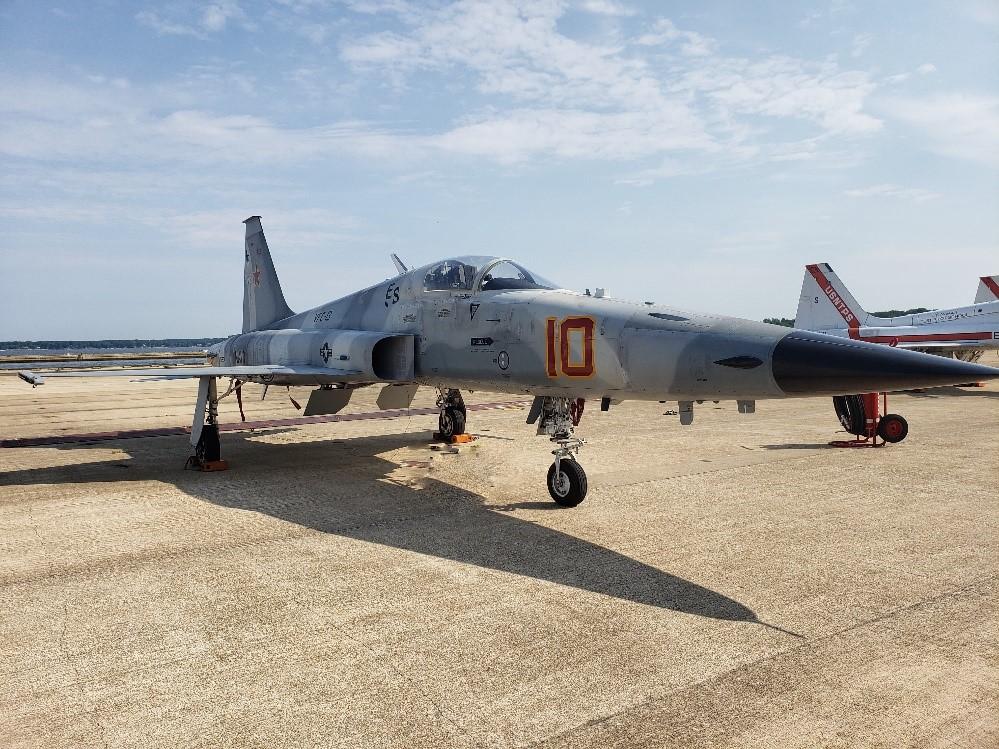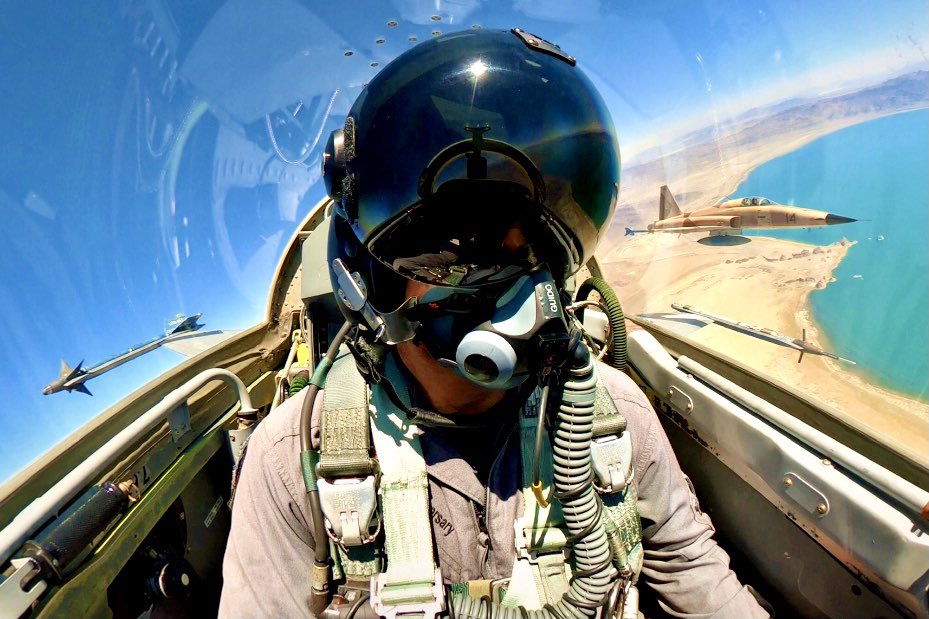As the U.S. Navy and Marine Corps set about overhauling their in-house red air adversary fleets, the first of three F-5N Tiger II aggressor aircraft set to undergo testing as part of a major upgrade program for the type arrived recently at Naval Air Station Patuxent River in Maryland. The improved F-5Ns will be better suited to replicate more advanced aerial threats and do so more reliably and safely. In the process, the Navy and Marine Corps are leveraging some of the capabilities that contractor red air providers have already introduced to the veteran F-5.
Naval Air Systems Command (NAVAIR) announced that its Specialized and Proven Aircraft Program Office, or PMA-226, which is responsible for managing the upgrade, had delivered the aircraft to Pax River earlier this week. The aircraft is now set to be used for ground and flight tests of this block upgrade prototype project for the Navy’s F-5s, also known as Avionics Reconfiguration and Tactical Enhancement/Modernization for Inventory Standardization, or ARTEMIS.

A photo the Navy released of the jet in question shows that it came from the service’s Fighter Squadron Composite 13 (VFC-13). It is not immediately clear to what degree the aircraft has already been upgraded under the ARTEMIS initiative.

ARTEMIS overhauls the jets’ airframes and their twin J85-21 engines, and replaces their avionics. In their revised configuration, the latter will be based around an open-architecture system including a modernized cockpit.
“This program will provide modernized aircraft with exceptional avionics and tactical capabilities which are needed to allow pilots to practice the tactics and techniques employed against a near-peer threat,” said Captain Ramiro Flores, the PMA-226 Program Manager. “Delivery of these improvements will ensure realistic and relevant tactical training the pilots need to win in combat.”
As well as boosting the overall capability of the aggressor jets, the upgrade aims also to improve their reliability and safety while addressing the various obsolescence issues that are affecting the F-5s, which date back to the 1970s. The Navy and Marine Corps Tiger IIs previously served as frontline fighters with Switzerland, the current batch being the survivors of 44 former F-5E/Fs acquired between 2006 and 2009.
But, as the Navy notes, the current configuration of the F-5 “lacks modern safety systems, avionics, and common tactical capabilities found in modern aircraft.”

On the safety side, ARTEMIS provides the F-5 with a new ground-proximity warning system to alert pilots if the jet is in immediate danger of flying into the ground or an obstacle. Other warning systems will provide alerts for severe weather as well as fuel levels.
To aid the aircraft’s primary aggressor mission, the upgrade will add “tactical capabilities designed to improve ‘friendly’ force air-to-air training,” according to the Navy.
All this work is handled by Tactical Air Support, Inc., which has already made a name for itself as a contractor operating upgraded F-5s. The firm received a sole-source firm, fixed-price, indefinite-delivery, indefinite-quantity contract for the upgrades to Department of the Navy-owned F-5s, running from March 2021 through March 2026.
As such, it’s expected the ARTEMIS package for the U.S. military will be based on, or at least broadly similar to, Tactical Air’s F-5 Advanced Tiger configuration, which the company applied to 21 former Jordanian F-5Es acquired in 2017. Those jets are already being used in support of Navy red air requirements at Naval Air Station Fallon, Nevada, the home of TOPGUN. In winning that high-profile contract, Tactical Air was selected ahead of a rival bid based around fourth-generation F-16 fighter jets, a turn of events you can read more about here.

The Tactical Air upgrade makes extensive use of commercial off-the-shelf components, and the company describes it as follows:
“Tactical Air’s F-5 Advanced Tiger (F-5AT) upgraded with HUD/HOTAS [head-up display and hands on throttle and stick controls], open architecture mission computers and tailored Operational Flight Programs that enable integration of Duotech’s Nemesis advanced radar and Argus RWR [radar warning receiver] systems, IRSTs [infrared search and track systems], EA [electronic attack], datalinks, and HOBS [high off-boresight] simulated weapons employment.”
Other specific items in the F-5AT package include a Duotech mission computer, threat weapons engagement zone (WEZ) replication software suite, a color multifunction display (MFD), and Garmin moving-map display. Meanwhile, the open-architecture avionics allows for rapid integration of an external or internal jammer, captive missiles, a P5 air combat maneuvering instrumentation pod, and various items of air-to-ground ordnance.

We also know that Tactical Air’s F-5 pilots are equipped with Scorpion full-color helmet-mounted displays, increasing lethality during simulated HOBS engagements and better replicating potential adversaries, as well as giving the pilot much improved situational awareness.
The end result, the company says, is a “fourth-generation adversary platform with third-generation economy.”
You can read our previous in-depth report on TacAir’s F-5 avionics upgrade here.

Ultimately, the results of the test program will inform the upgrade work that’s going to be carried out on a total of 22 former Swiss Air Force Tiger IIs (16 single-seat F-5E and six dual-seat F-5F variants) that have been recently acquired to boost the adversary force available to the Navy and Marines, reflecting a growing demand for red air across the board.

Once they’ve undergone the ARTEMIS upgrade, the jets will be re-designated F-5N+ and F-5F+. A first upgraded Tiger II is reportedly expected to be delivered toward the end of next year.
After work on the 22 recently acquired F-5s has been completed, the Navy plans to introduce the ARTEMIS upgrade on the existing Navy and Marine Corps F-5 aggressor fleet, covering a planned 40 aircraft.
While they are not typically used to replicate high-end threats, the F-5 continues to be best suited to simulating low-to-mid level threats. The jets today serve with VFC-13 at Naval Air Station Fallon, Nevada, and VFC-111 at Naval Air Station Key West, Florida, while the Marine examples are operated by Marine Fighter Training Squadron 401 (VMFT-401) at Marine Corps Air Station Yuma, Arizona.

Tactical Air’s reworking of the Navy and Marine Corps aggressor F-5s will result in some of the most advanced Tiger IIs anywhere in the world. Already a tricky opponent on account of its small size and its agility, the jet is no match for today’s high-end fighters, but, once upgraded, will become a much more capable and flexible adversary.
The War Zone has, in the past, looked in detail at the various capabilities that Tactical Air’s F-5 aggressor upgrade brings to the table. As well as the helmet-mounted display, the Nemesis pulse-Doppler radar is judged to be better than the AN/APG-66 radar used in contractor-operated A-4 Skyhawks, although it’s not at the same level as the active electronically scanned array (AESA) radars beginning to appear in some jets in the private aggressor community. However, the Nemesis also has the potential to be upgraded with an AESA antenna in the future. Raytheon, for example, recently unveiled a compact, affordable AESA radar weighing a little over 100 pounds, that would seem to be pitched toward this segment of the adversary air market in particular.

There have also been upgrades made to the existing F-5s, notably the “Red Net” tactical and situational awareness datalink introduced on the Marine Corps jets with VMFT-401. Based around a commercially available tablet-kneeboard display, this operates much like a heads-down situational display, feeding the pilot with information that can flow from other platforms — including those carrying more advanced radars and sensors, for example, even in a synthetic manner.
The relatively cheap to operate upgraded F-5s combined with more advanced adversaries and electronic warfare support, as well as contracted aggressors, will be able to challenge fleet pilots with a saturated and dynamic threat presentation. This is highly important not just because of the rising capabilities of America’s adversaries, but also because of the increasing capabilities of the combat aircraft fleet pilots fly. Advanced sensors and data links, as well as better weaponry, have made it harder and harder to challenge them in the air with an increasingly geriatric aggressor force. This upgrade aims to help in that department.
Of course, the Navy and Marines will not primarily be using their upgraded F-5s to represent the highest-level threats, leaving that job to the F/A-18E/F Super Hornet and to the F-16, and potentially even the F-35. The War Zone was first to reveal plans for VFC-12 to upgrade from the “classic” Hornet to the Super Hornet, while the service is bringing in additional F-16 aggressor jets to Fallon to supplement the limited numbers of available F/A-18E/F Super Hornets and F-16A/B Vipers. As we understand it, some of these F-16s will fly with VFC-13, which now flies the F-5N.
Thanks to the influx of 22 additional jets combined with the Tactical Air upgrade package, the F-5 is set to continue its formidable legacy as an aggressor jet, offering both numbers, economy, and a very useful level of capability, staying relevant even in the age of fifth-generation fighters and beyond.
Contact the author: thomas@thedrive.com
